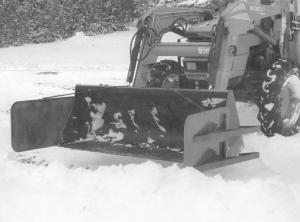2008 - Volume #32, Issue #6, Page #11
[ Sample Stories From This Issue | List of All Stories In This Issue | Print this story
| Read this issue]
"Snow Boards" Mount On Front Loader Bucket
 |
Peash uses the snow boards on his Kubota 54 hp tractor equipped with a Woods 1027 front-end loader. "The loader bucket is 71 in. wide but the boards extend that width to 91 in. when in the retracted position, and to 116 in. when in the extended (plowing) position," he says.
The snow boards consist of a pair of 35-in. long by 20-in. high steel plates equipped with heavy duty hinges that bolt onto both sides of the loader bucket. A pair of bungee cords are used to keep the snow boards in the retracted position when not in use.
As soon as snow builds up on the bucket, the boards start moving outward. When they reach a 45 degree angle they're stopped by a pair of triangular, flanged gussets that contact the bucket's side walls. When Peash raises the bucket and dumps the load, the spring-loaded bungee cords pull the snow boards back into the retracted position.
"They work great. I load the bucket until the tractor can't push it any more and can push almost two and a half times more snow than I can with the bucket by itself," says Peash. "As the boards open up they're ahead of the bucket so they tend to shove the snow toward the center. I can really get a good load. I think the same idea could be adapted to a variety of loader sizes. Small hydraulic or pneumatic cylinders could be used instead of bungee cords for improved control."
He uses the loader to plow his driveway and yard, where he stores round hay bales for sale. "My customers have to drive their trucks over the yard, which then becomes uneven. By itself, the bucket's blade can easily dig into the grass and make a big mess, especially when snow falls on unfrozen ground. The boards help keep the bucket from scalping the grass because they have rounded leading edges on the bottom. Another advantage is that I can reach under buildings with low roof eves without worrying that my tractor cab might contact the roof overhang."
He used 3/16-in. thick steel to build the boards. The hinges are 1/4-in. thick steel. Each board is attached with two 3/4-in. bolts that go through existing holes in the bucket, which Peash enlarged. "It takes only about 15 minutes to put the snow boards on or off," says Peash.
"I'm a retired engineer and made drawings which I took to a local welding company. They charged me $175 apiece to cut out the snow boards and weld them together," he notes.
Contact: FARM SHOW Followup, Douglas Peash, 2423 Maynard Rd., Cheboygan, Mich. 49721 (ph 231 627-3435; dpeash@freeway.net).

Click here to download page story appeared in.

Click here to read entire issue
To read the rest of this story, download this issue below or click here to register with your account number.




